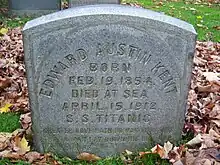Edward Austin Kent
Edward Austin Kent (February 19, 1854 – April 15, 1912) was a prominent architect in Buffalo, New York. He died in the sinking of the RMS Titanic and was seen helping women and children into the lifeboats.[1]
Edward Austin Kent | |
|---|---|
 | |
| Born | February 19, 1854 |
| Died | April 15, 1912 (aged 58) |
| Nationality | American |
| Alma mater | Yale University École des Beaux-Arts |
| Occupation | Architect |
| Parent(s) | Henry Mellen Kent Harriet Ann Farnham |
Biography
Edward Austin Kent was born in Bangor, Maine on February 19, 1854 to Harriet Ann Farnham (1830–1908) and Henry Mellen Kent (1823–1894).[2] Kent moved with his family to Buffalo after the American Civil War, where his father, Henry, opened a successful department store, Flint & Kent. He was the brother of William Winthrop Kent (1860–1955),[3][4] also a prominent architect who studied under H. H. Richardson,[5][2] and Charles Farnham Kent (1856–1878), who died aged 22 in Denver, Colorado.[6] Kent attended and graduated from Yale, in 1875,[7] and later the École des Beaux-Arts, the famous Beaux-Arts architecture school in Paris. Returning to the U.S. in 1877, he became junior partner in the Syracuse, New York firm of Silsbee and Kent. In 1884, he returned to Buffalo and remained there for the rest of his career, helping to found the Buffalo Society of Architects and receiving many prominent commissions, including Flint & Kent.[8] Until his death, he lived at the Buffalo Club.[9]
In 1912, he took a two-month vacation to France and Egypt and planned on retiring after returning home. He decided to delay his trip home so he could travel on the maiden voyage of the new and luxurious ocean liner, the RMS Titanic.
Aboard the Titanic

Kent traveled as a first-class passenger. He mingled with the other socialites, and with a writers' group which included Helen Churchill Candee and Archibald Gracie. He perished when the ship struck an iceberg and sank on the night of April 14–15, 1912. As the ship was sinking, he disregarded his own safety to help women and children into the lifeboats. He was last seen at around 2:20 a.m. making no attempts to save himself as he was swept into the ocean. His body was recovered by the CS Mackay-Bennett as body No. 258 and claimed by his brother when the ship docked. He was laid to rest in the Forest Lawn Cemetery in Buffalo, New York.[1][10]
Notable works
- Temple Beth Zion (destroyed) - erected in 1890 at 599 Delaware Avenue in Buffalo, New York. Destroyed on October 4, 1961, when a fire, fueled by flammable liquids being used to refinish the pews, destroyed the building.[11]
- Chemical No. 5 Firehouse - erected in 1894 in the Art Nouveau style at 166 Cleveland Avenue in Buffalo, New York.
- A. E. Perron Company Building - erected in 1895 in the Beaux-Arts style at 674 Main Street as a factory and sales room for the A. E. Perron Company, a manufacturer of early automobiles, sleighs and harnesses.[12]
- Otto-Kent Building - erected in 1896 in the Beaux-Arts style at 636-644 Main Street in Buffalo, New York adjacent to Shea's Buffalo for his father's department store, Flint & Kent
- Unitarian Universalist Church of Buffalo - erected in 1906 in the English Gothic style at 695 Elmwood Avenue in Buffalo, New York and listed on the National Register of Historic Places on June 30, 2015.[13]
See also
References
- "Mr. Edward Austin Kent". Encyclopedia Titanica.
- Kent, William Winthrop; Jacob, Hilda McLeod. "William Winthrop Kent Correspondence". digitalmaine.com. Maine State Library. Retrieved 28 April 2017.
- Times, Special To The New York (11 November 1955). "Obituary 1 -- No Title". The New York Times. Retrieved 28 April 2017.
- "William Winthrop Kent (Kent, William Winthrop, 1860-1955)". onlinebooks.library.upenn.edu. University of Pennsylvania. Retrieved 28 April 2017.
- "Oliver T. Sherwood House, Southport Connecticut". historic-structures.com. Historic Structures. Retrieved 28 April 2017.
- "DIED". Bangor Daily Whig and Courier. October 9, 1878.
- Schiff, Judith. "When the Titanic went down | Six Yale men were aboard". Yale Alumni Magazine (Mar/Apr 2012). Retrieved 28 April 2017.
- Parke, Bill. "Edward Austin Kent in Buffalo, NY". buffaloah.com.
- "Edward A. Kent of Buffalo". The New York Times. 16 April 1912. Retrieved 28 April 2017.
- Times, Special To The New York (2 May 1912). "TITANIC DEAD TO BE BURIED IN HALIFAX; Unidentified and Unclaimed Bodies Will Be Interred Friday by Direction of Coroner". The New York Times. Retrieved 28 April 2017.
- "Temple Beth Zion". buffaloah.com. Retrieved 1 September 2015.
- Staff (25 April 2017). "On the Market: 674 Main Street". Buffalo Rising. Retrieved 28 April 2017.
- "National Register of Historic Place Listings". nps.gov. National Register of Historic Places. Retrieved 1 September 2015.
